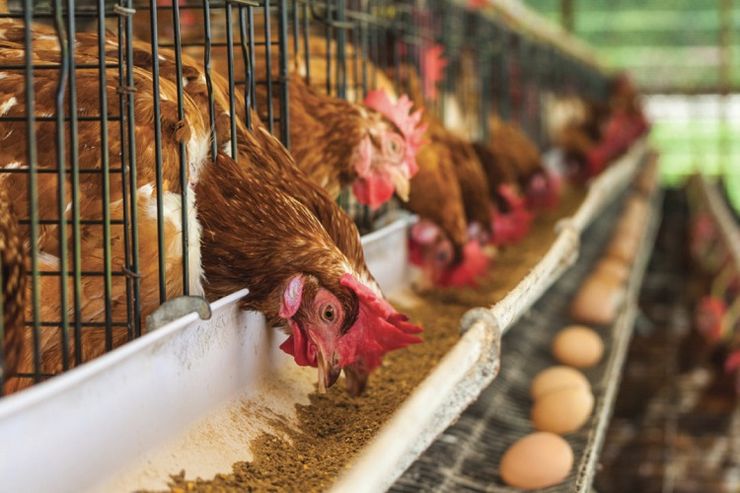Small but stable poultry and egg production in Ivory Coast

While broiler production in the Ivory Coast has enjoyed an average annual growth of 13.8% since 2009, production figures have seen a downward spiral in recent years. The government, however, has plans to boost the poultry meat and egg sectors.
Up to 60% of the local poultry sector in the Ivory Coast is attributed to backyard production, and while there exists there are commercial producers and some large-scale commercial farmers, most production units are either small (50-1,000 birds) or medium-sized farms (1,000-10,000 birds). Commercial production, however, is growing with the increasing demand for poultry products.
Over the last 3 years, the sector has been battling like others worldwide against avian influenza outbreaks, and more recently, Covid-19 and the war in Ukraine have also dramatically impacted production due to increased freight costs for production inputs.
Domestic broiler production is spread across approximately 1,500 broiler farms. In 2021, production is estimated at 46,795 mt, down 11% from 2020. Local farmers have also experienced lower corn harvests due to increasing input costs (mostly fertilizer) which have dramatically impacted corn production, which industry sources estimate has decreased by 30% over the last 3 years, which in turn has reduced the amount available for poultry feed. The price of imported corn has also increased.
Hens are housed across 700 layer farms in the Ivory Coast, and in 2021, egg production is estimated at 1.133 billion units. The country has 22 chick hatcheries, a third of which are believed to operate at a commercial level. The hatcheries produced 61 million day-old chicks in 2020. While the USDA forecasts this figure to drop to 54.9 million in 2022, it is expected the figure will reach a production capacity of 70 million day-old annually in 2023.
In 2022, poultry meat consumption is expected to remain stable at 2.65 kg per person. From 2010 to 2020, chicken meat consumption trended upward in Côte d’Ivoire alongside a decline in the price of meat for consumers. Total consumption of chicken meat was 23,000 mt in 2010, which is a consumption rate of 1.1 kg per person. Broiler meat prices rose 28% in 2021, mostly due to the increase in the price of feed.
Despite the rise in chicken prices, the USDA expects an overall increase in demand for chicken meat in the coming years with poultry meat remaining one of the most competitive in terms of price. In addition, the middle class in the Ivory Coast is increasing, which will drive demand. The Ministry of Animal and Fisheries Resources oversees the poultry sector and aims to increase meat consumption to 6.2kg by 2030.
Post estimates that egg consumption will also grow soon for the same reason stated above. Egg consumption in the Ivory Coast increased 67% over the past 12 years, reaching 52 eggs per person per year in 2020. In the next 5 years, it is expected that demand for both eggs and chicken will outstrip the current supply with an expected egg consumption rate of 86 eggs per person in 2025. The Ministry of Animal and Fisheries Resources aims to increase egg consumption to 100 units by 2030.
Poultry feed in Côte d’Ivoire generally includes a mix of corn, soybean, cotton seed cake, palm oil cake, wheat bran, fish, and various other components. Soybean (17 mt in 2021) and wheat are currently imported, mainly from Argentina and Brazil, while corn, the main ingredient in poultry feed and a prominent ingredient in local diets, is grown locally with an average annual production of 600,000 mt. The average yield for local corn is 1 tonne/ha. This is lower than many other producing countries due to a lack of mechanisation, fertiliser, and training gaps among farmers. Additional corn is imported, mostly imported from South American countries. The cost on imported corn has increased about 30% since the pandemic, while domestic corn prices increased by 150% over the last 2 years.
Côte d’Ivoire’s 2022 chicken meat imports are forecast at 985 mt, nearly a 21% decrease from the 1,211 mt imported in 2021. The country does not import much chicken meat, since local supply provides almost all local demand. Poultry meat is imported mainly from Poland, France, the Netherlands, Spain, and Germany. The country exported just 215 mt of poultry products in 2021 to neighbouring countries, mostly Burkina Faso.
While large-scale farmers usually sell their products to wholesalers, hotels, and supermarkets, small and medium scale farmers usually sell their birds to wet market sellers, often live or after being slaughtered and prepared by service providers at the market. Broilers are sold at an average price of US$2.07/kg and layers at US$2.57/kg from farmers to market sellers, who then add their margin. Layers are more expensive due to their highly preferred taste for local dishes. During periods of high demand, such as Easter and Christmas, the price can nearly double. The retail price for broilers is US$2.51/kg and for layers US$3.22/kg.
Eggs are usually sold in a tray of 24 and have an average price of US$3.05 when bought from the farm and US$4.02 when purchased at a grocery store. Like broiler and layers, they see the price increase during festivals and holidays when demand jumps.
Read also
Wheat in Southern Brazil Impacted by Dry Weather and Frosts
Oilseed Industry. Leaders and Strategies in the Times of a Great Change
Black Sea & Danube Region: Oilseed and Vegoil Markets Within Ongoing Transfor...
Serbia. The drought will cause extremely high losses for farmers this year
2023/24 Safrinha Corn in Brazil 91% Harvested
Write to us
Our manager will contact you soon



